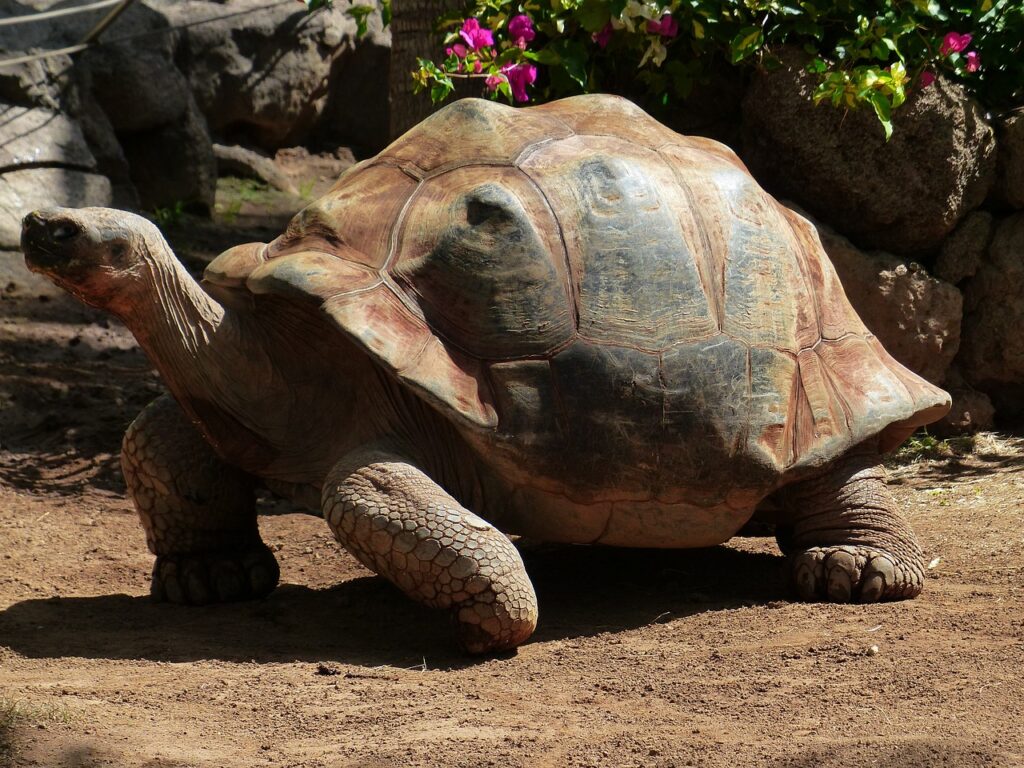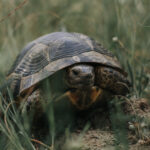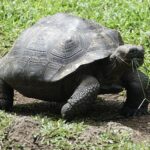Baby Sulcata tortoises are all about the greens! Leafy greens like dandelion, kale, and collard all make up their diet. These nutrient-rich veggies give them essential vitamins, minerals, and fiber for healthy development.
To mix it up, try adding a variety of vegetables like carrots, bell peppers, and squash. Chop or shred the food to help with digestion and avoid high-protein or high-fat foods like meat or dairy.
Consult a vet specializing in reptile care for tailored advice on nutrition. With the right balance and variety, your baby tortoise will be happy and healthy!
Key Takeaways
- Baby Sulcata tortoises have specific dietary needs that must be met for their growth and development.
- Their diet should consist mainly of leafy greens, such as kale, collard greens, and dandelion greens.
- It is important to provide a variety of vegetables and fruits to ensure a balanced diet.
- Calcium and vitamin supplements should be added to their food to prevent deficiencies.
- Avoid feeding them high-protein foods, such as meat or dairy products, as it can lead to health issues.
- Baby Sulcata tortoises should have access to fresh water at all times.
- It is crucial to monitor their diet and adjust it as they grow to meet their changing nutritional needs.
What Do Baby Sulcata Tortoises Eat?

Baby Sulcata tortoises have specific dietary needs that must be met for their optimal growth and development. These adorable creatures require a balanced diet that includes a variety of foods. Here is a list of key foods that baby Sulcata tortoises eat:
- Grasses: Grasses should form the bulk of a baby Sulcata tortoise’s diet. Fresh, low-protein grasses like Bermuda grass and Timothy grass are recommended.
- Leafy Greens: Providing leafy greens such as collard greens, dandelion greens, and kale is essential for their nutritional requirements.
- Hay: High-quality hay, such as Timothy hay, helps provide additional fiber and encourages healthy digestion.
- Vegetables: Baby Sulcata tortoises can also consume various vegetables to supplement their diet. Some examples include carrots, bell peppers, and squash.
- Flowers: Edible flowers like hibiscus, daisies, and roses can be offered to baby Sulcata tortoises as a treat, providing both nutrition and enrichment.
- Calcium Supplements: Calcium is crucial for their bone development. A calcium supplement should be regularly sprinkled over their food, ensuring they receive adequate amounts.
It is important to note that baby Sulcata tortoises should avoid certain foods, such as those high in protein or sugar. Additionally, any food provided should be pesticide-free to ensure their well-being.
One unique detail to consider is that baby Sulcata tortoises have a high-water requirement. It is crucial to provide them with a shallow water dish for drinking and soaking. This helps them stay hydrated and promotes healthy shell growth.
By providing a well-rounded diet consisting of a variety of grasses, leafy greens, hay, vegetables, flowers, and calcium supplements, you can ensure the healthy growth and development of your baby Sulcata tortoise.
Don’t miss out on providing your baby Sulcata tortoise with a balanced diet. Ensuring their nutritional needs are met from an early age is crucial for their overall health and well-being. Start by offering them the recommended foods and watch them thrive as they grow into magnificent adults.
Get ready to meet the Sulcata tortoise, the pickiest eater in the reptile world who can turn a dinner party into a lettuce-only affair.
Overview of Sulcata Tortoises
Sulcata tortoises are extraordinary creatures with peculiar characteristics that make them stand out from other tortoise species. These tortoises, better known as African spurred tortoises, are the third-largest species of tortoise in the world and can be found in the sub-Saharan region of Africa.
- Size: Males grow to be around 30 inches long and can weigh more than 100 lbs. Females are a bit smaller.
- Lifespan: These tortoises can live for over 70 years in captivity and maybe even longer in the wild.
- Habitat: They are adapted to arid climates and can be found in grasslands and savannas where they feed on grasses and plants.
- Diet: Sulcata tortoises love broadleaf weeds and succulents. However, they need a balanced diet that also includes greens like kale, collard greens, and dandelion greens.
- Care: As pets, they need a lot of space. An outdoor enclosure with plenty of sunlight is ideal for them. Correct temperatures are also essential for their health.
- Conservation Status: Sadly, these tortoises are considered vulnerable due to habitat destruction and illegal trade. We need to make people aware of their conservation needs so that future generations can enjoy them.
Moreover, these tortoises grow at a rapid rate in their first few years of life – up to two pounds a month! This is because of their proficient metabolism and their ability to store water in their bodies.
In the 1970s, lots of these tortoises were brought to the United States for the pet trade. Unfortunately, many people didn’t realize how big they would get or how long they would live, leading to a lot of abandoned or neglected tortoises. This influx of sulcata tortoises notably impacted certain areas of the country, especially states with warm climates where they can thrive.
Feeding baby Sulcata tortoises is critical. They need proper nutrition, as much as it takes to beat a snail in a marathon!
Nutritional Needs of Baby Sulcata Tortoises
Baby Sulcata Tortoises have specific nutritional needs. To ensure their health, provide a balanced diet! Fresh veggies, hay, calcium and limited fruit are key. Variety is essential too! Plus, always provide shallow water. UVB lighting helps with calcium absorption and shell growth. Over time, research and experience has enabled us to provide optimal care for these creatures. Feeding a baby Sulcata Tortoise? Think ‘Guess the Food’ – they’ll eat anything that fits!
Recommended Diet for Baby Sulcata Tortoises
The recommended diet for baby Sulcata tortoises can vary, but it typically consists of a balanced mix of leafy greens, vegetables, and high calcium foods. Fiber-rich foods are important as well. Sulcata tortoises should be fed a variety of plants to ensure they receive all the necessary nutrients. Additionally, it is crucial to avoid feeding them foods that are toxic to reptiles, such as rhubarb and avocado. A proper diet is essential for the healthy growth and development of baby Sulcata tortoises.
- Leafy greens: Baby Sulcata tortoises should be offered a variety of leafy greens, such as kale, collard greens, and dandelion greens. These provide essential vitamins and minerals.
- Vegetables: Along with greens, a mix of vegetables like bell peppers, carrots, and squash should be included in their diet. These vegetables provide additional nutrients and variety.
- High calcium foods: Providing foods high in calcium, such as calcium-rich pellets or calcium supplements, is crucial for the development of a baby Sulcata tortoise’s shell and overall health.
- Fiber-rich foods: Offering fiber-rich foods like grasses or hay helps baby Sulcata tortoises maintain a healthy digestive system.
- Avoid toxic foods: It is important to be aware of foods that are toxic to tortoises and avoid feeding them to baby Sulcatas. Examples include rhubarb and avocado, which can be harmful or even fatal.
- Variety is key: Baby Sulcata tortoises benefit from a diverse diet, so offering a range of suitable vegetables, greens, and calcium sources helps ensure they receive all the necessary nutrients.
In addition, it’s important to monitor their diet and adjust accordingly as they grow. Providing fresh water for drinking and soaking is also essential for their hydration.
When it comes to feeding baby Sulcata tortoises, a balanced and diverse diet is crucial for their growth and development. By following these guidelines and regularly monitoring their diet, you can help ensure that your baby Sulcata tortoise has the best chance of thriving.
Now that you have a better understanding of the recommended diet for baby Sulcata tortoises, make sure to provide them with the necessary nutrition to support their growth and well-being. Don’t miss out on the opportunity to give your tortoise the best start in life by following these feeding guidelines and offering a diverse range of suitable foods. Your baby Sulcata tortoise will thank you!
Fresh water may not make baby sulcata tortoises do backflips, but it’s still essential for their survival – no dive clubs for these little guys.
Source of Fresh Water
Baby Sulcata tortoises need fresh water for their health and growth. A shallow bowl they can easily access is recommended. Change and clean the water daily to prevent contamination.
Tap water is okay, but commercial water conditioners must remove chlorine and other toxic chemicals first. Filters or reverse osmosis filtration systems can also help remove impurities from the water.
Rainwater is an ideal source of fresh water because it’s naturally pure. But collect it in a clean container away from pollutants. Bottled spring water, with no additives or chemicals, can be another option.
Remember to serve the water at room temperature. Cold or hot water can cause stress to these sensitive creatures.
Leafy Greens and Vegetables
Leafy greens and veggies are super important for your baby sulcata tortoise’s diet! These nutrient-filled foods give them the vitamins and minerals they need to grow and stay healthy.
Mix up their meals with different leafy greens and veggies. Here’s a few ideas: kale, collard greens, mustard greens, dandelion greens, squash, carrots, bell peppers, and zucchini. Wash them carefully to get rid of any pesticides.
You can also give them spinach, Swiss chard, and romaine lettuce occasionally. But don’t make them the main source of leafy greens.
Offering a variety of leafy greens and veggies will keep your baby sulcata tortoise interested in meals and ensure they get all the nutrients they need. Start including them in their diet today!
Give your baby sulcata tortoise a balanced diet and help them stay healthy. Watch them munch through more hay and grasses than a goat at a buffet – showing that slow and steady can still be voracious!
Hay and Grasses
Hay and grasses are vital for baby Sulcata tortoises’ diets. They provide essential nutrients for growth and development. Let’s explore the different types of hay and grasses that can be included:
- Timothy Hay
- Alfalfa Hay
- Oat Hay
- Meadow Hay
- Bermuda Grass
- Rye Grass
- Fescue Grass
- Orchard Grass
Timothy Hay has high fiber, aiding digestion. Alfalfa Hay provides protein and calcium for growing bones. Oat Hay has a variety of nutrients and encourages natural feeding. Meadow Hay adds diversity with needed fiber.
Long ago, Sulcata tortoises roamed African grasslands. They ate various grasses in the wild. As they adapted, their diet expanded to include hay.
Hay and grasses have a long history of nutrition for baby Sulcata tortoises. Including them ensures these creatures get a balanced diet, like their natural home. A diet of tortoise pellets is the ideal choice for slow and steady growth, just like their happy tortoise bellies!
Commercial Tortoise Pellets
Commercial tortoise pellets are perfect for baby sulcata tortoises. They have essential nutrients like calcium, vitamins, and high-quality protein. They provide a balanced diet and meet the specific dietary needs of young tortoises.
There are two popular brands to choose from:
| Brand | Nutritional Content | Price |
|---|---|---|
| Brand A | High fiber & calcium, low fat | $10 for 5 pounds |
| Brand B | Vitamins, minerals, & antioxidants | $15 for 10 pounds |
When tortoises reach adulthood, they can have a more varied diet. But during their growth stage, pellets should form the basis of their meals.
Emma from California is a huge supporter of these pellets. After introducing them to her baby tortoise, she saw a drastic improvement in its health and shell. Now her tortoise is lively and healthy!
These pellets are a great way to ensure your pet gets the nourishment it needs. So if you want an easy way to keep your furry friend healthy, give these pellets a try!
Feeding Techniques for Baby Sulcata Tortoises: Be prepared to wait a long time for them to eat—they’re quite slow.
Feeding Techniques for Baby Sulcata Tortoises

Feeding Techniques for Baby Sulcata Tortoises:
Baby Sulcata tortoises have specific feeding requirements to ensure their growth and development. Here are three key techniques to follow:
- Diet Composition: Provide a balanced diet consisting of a variety of fresh vegetables, such as dark leafy greens, carrots, and bell peppers. Additionally, include small amounts of fruit like apples or berries as occasional treats.
- Calcium and Vitamin Supplementation: Sprinkle calcium and vitamin supplements on their food to ensure they receive adequate nutrition. This helps promote healthy shell growth and overall well-being.
- Feeding Schedule: Feed baby Sulcata tortoises daily to support their rapid growth. Offer food in the morning or early afternoon and remove any uneaten portions to maintain cleanliness.
It is important to note that baby Sulcata tortoises have unique dietary needs, so consult a reptile veterinarian or expert for further guidance and assistance.
In addition, it is recommended to provide a shallow dish of clean water for the tortoise to drink and soak in. This helps prevent dehydration and aids in digestion.
To ensure optimum health and proper development, it is crucial to monitor the tortoise’s weight and adjust the feeding regimen accordingly. Regularly assess their growth and adjust the food quantity and frequency as they mature.
By following these feeding techniques, baby Sulcata tortoises can thrive and grow into healthy adults.
You know what they say, little Sulcata tortoises have big appetites – they would eat you out of house and shell if they could!
Frequency of Feeding
Feeding baby Sulcata tortoises is key. Frequency affects their growth and development. Here’s a feeding schedule:
- 0-6 months: Daily.
- 6-12 months: Every 2 days.
- 1-2 years old: Every 3 days.
Gotta offers a variety of natural foods: leafy greens, vegetables, fruits, and occasional protein sources like insects or worms. That’s how they stay healthy.
There’s a story of a tortoise enthusiast with a baby Sulcata named Sheldon with an odd appetite. He liked watermelon rinds more than the juicy fruit! Each tortoise has its own preferences.
So, remember, feed them with the right frequency for healthy growth. Give them a nutritious diet suited to their needs!
Feeding Schedule
For your baby Sulcata Tortoise, you need a well-thought-out feeding plan. Here are three things to keep in mind:
- Variety: Provide a range of greens, veggies, and sometimes fruits in their diet. This makes sure they get all their nutrients.
- Frequency: Give smaller meals every day, just like they would graze in the wild.
- Calcium supplement: Sprinkle food with calcium for strong shell growth.
Moreover, high-protein or high-fat food can be bad for them. A steady diet is key for their healthy development.
Pro Tip: When adding new foods, do it slowly to avoid digestion issues.
And remember, when it comes to your baby sulcata tortoise, don’t overfeed – unless you want to launch ‘Turtle Weight Watchers’!
Portion Sizes
Determining portion sizes for baby Sulcata tortoises is key. For guidance, here’s a table based on age and weight:
| Age | Weight | Portion Size |
|---|---|---|
| 0-3 months | 10-50 grams | Around 10% of body weight in dark leafy greens, twice a week with calcium-rich food. |
| 4-6 months | 50-100 grams | 8-10% of body weight in dark leafy greens, increased calcium every other day. |
| 7-12 months | 100-200 grams | 7% of body weight in dark leafy greens, plus veggies and some fruit. |
These are general guidelines. Monitor growth, adjust diet and ensure balance for health and longevity. And, remember: no overfeeding! It can lead to shell deformities and other health issues.
Feeding Tips and Considerations: Here’s how to satisfy little appetites and avoid kitchen protests.
Feeding Tips and Considerations
Feeding Tips and Considerations for Baby Sulcata Tortoises:
Sulcata tortoises require a specific diet to ensure their proper growth and development. Here are some essential feeding tips and considerations to keep in mind:
| Diet | Example |
|---|---|
| Vegetables | Kale, collard greens, dandelion greens |
| Fruits | Strawberries, apples, melons |
| Hay | Timothy, Bermuda, orchardgrass |
| Supplements | Calcium, vitamin D3 |
It is important to note that not all vegetables and fruits are safe for sulcata tortoises. Avoid feeding them toxic plants such as rhubarb or avocado. Additionally, make sure to provide a varied diet to ensure they receive all the necessary nutrients.
To further promote healthy growth, provide access to fresh water at all times. Baby sulcata tortoises need to stay hydrated for proper digestion and overall well-being. Clean the water dish regularly to maintain its cleanliness.
A True Story:
A tortoise owner, Maria, struggled to find the right balance in her baby sulcata tortoise’s diet. After seeking advice from a reptile expert, she learned the importance of a varied diet and proper supplementation. Following the recommended guidelines, Maria’s tortoise thrived and grew into a healthy adult.
Remember, understanding the dietary needs of baby sulcata tortoises and following these feeding tips and considerations will help ensure their long-term health and well-being. It’s like giving a turtle a milkshake, you wouldn’t catch a baby sulcata tortoise without its calcium and vitamin supplements.
Calcium and Vitamin Supplements
Let’s check out the benefits & intake of Calcium & Vitamin Supplements!
| Supplement Type | Benefits | Intake |
|---|---|---|
| Calcium | Supports bones & teeth | 1000-1300 mg/day |
| Vitamin D | Aids calcium absorption | 600-800 IU/day |
| Vitamin C | Boosts collagen production | 75-90 mg/day |
Calcium is a must for strong bones & teeth. It prevents osteoporosis, a condition of weak & brittle bones. Adults need 1000-1300 mg/day. Sources include dairy, greens, cereals & supplements.
Vitamin D & Calcium work together for bone health. It increases calcium absorption from the intestine. The daily intake should be 600-800 IU. Sources include sunlight, fatty fish, egg yolks & fortified foods.
Vitamin C helps collagen synthesis, important for skin, joints & blood vessels. It’s an antioxidant & is also needed for cell protection. 75-90 mg/day is recommended. Sources include citrus, berries, peppers, tomatoes, broccoli & supplements.
Pro Tip: Supplements can help meet nutrient needs in certain cases. But, it’s best to get nutrients from a balanced diet. Always consult a healthcare professional before taking any supplements.
By knowing the benefits & intake of Calcium & Vitamin Supplements, you can make informed decisions for your daily routine & health.
Warning: Avoiding certain foods can lead to ‘hanger’ – unpredictable outbursts & uncontrollable pizza cravings at 3 am!
Avoidance of Certain Foods
To ensure a good feeding routine, certain foods should be avoided. These can have a big effect on your health.
- Processed foods: Don’t eat artificially flavoured or sweetened foods. They often have preservatives and chemicals which can be bad for you.
- Allergenic foods: Find out if you have any allergies or sensitivities that could cause problems. This may include peanuts, shellfish, or gluten.
- Highly sugary foods: Too much sugar can cause weight gain and increase the chances of diabetes or heart disease. Limit sugary snacks and drinks for better health.
These factors not only make you healthier but also give your immune system a boost and stop health issues from happening.
Here are some other ideas to help you:
- Eat whole foods: Eating fruit, vegetables, lean protein, and whole grains gives you the nutrients you need without bad additives. This helps you maintain balance.
- Read labels: Have a look at ingredients and nutrition info when you buy food. Avoid products with long lists of unknown ingredients or those high in unhealthy fats and sugar.
- Get professional advice: Speak to a dietitian who can work out what you need and give you advice on avoiding certain foods.
By choosing what we eat, we can take control of our health. Avoiding foods that harm us lets us stay energetic, vital, and live longer. That’s the way to a healthy lifestyle! Plus, keep an eye on your tortoise’s growth and health; that way you can show everyone that they’re not just slow-moving rocks!
Monitoring the Tortoise’s Growth and Health

Monitoring your tortoise’s growth and health is vital for their welfare. Keeping an eye on their development and overall health can help you address any problems early. A great way to track their progress is to keep a record of their weight, length, and general physical condition.
Here’s a useful table:
| Date | Weight (grams) | Length (inches) | Condition |
|---|---|---|---|
| 01/01/2022 | 150 | 4.5 | Good |
| 02/01/2022 | 155 | 4.7 | Good |
| 03/01/2022 | 160 | 4.9 | Good |
This lets you see any changes in weight and length over time which can show if your tortoise is growing properly or not. Also, noting their condition can show any health issues.
Apart from this, pay attention to other specific details about your tortoise’s behavior and habits. For example, if they have a decreased appetite or seem more lethargic. These can help you understand their well-being and may require more attention or professional help.
Pro Tip: Monitoring your tortoise is important. But remember that each tortoise has their own growth rate and behavior. Speak to a reptile vet for advice about your tortoise’s species and needs.
Feeding Tips and Considerations: Food is essential, but laughter is the best medicine. Especially when your pet mistakes you’re cooking for a science experiment!
Frequently Asked Questions
1. What do baby Sulcata tortoises eat?
Young Sulcata tortoises primarily eat vegetation such as grasses, weeds, and leafy greens. It is important to provide a varied diet to ensure proper nutrition.
2. Can baby Sulcata tortoises eat fruits?
While fruits can be offered occasionally as a treat, baby Sulcata tortoises should primarily consume a diet consisting of high-fiber, leafy green vegetation. Fruits should be given sparingly due to their high sugar content.
3. Do baby Sulcata tortoises need supplements?
Yes, it is beneficial to provide baby Sulcata tortoises with calcium and vitamin supplements. These supplements help promote healthy shell growth and prevent deficiencies.
4. Should baby Sulcata tortoises be given commercial tortoise food?
While commercial tortoise food can be offered, it should not be the sole diet for baby Sulcata tortoises. Fresh vegetation should always be the main component of their diet, with commercial food serving as occasional supplements.
5. How often should baby Sulcata tortoises be fed?
Baby Sulcata tortoises should have access to fresh food every day. Feeding small portions multiple times a day is ideal to mimic their natural grazing behavior.
6. Can baby Sulcata tortoises eat lettuce?
Lettuce, particularly iceberg lettuce, is not recommended for baby Sulcata tortoises. It lacks significant nutritional value and can cause digestive issues. Opt for healthier dark leafy greens instead.
Conclusion
When it comes to baby sulcata tortoises, their diet mainly consists of leafy greens and grasses. But, as they grow older, they may require a variety of fruits and veggies too! Calcium is also important for their shell development – add cuttlefish bone or calcium supplements to their meals.
Interestingly, I once met one that disliked greens. Despite many tries, the tortoise simply refused! But eventually, it was found that hibiscus flowers were its favorite. So, this became a regular part of its diet – giving it the nutrients it needed.
References




